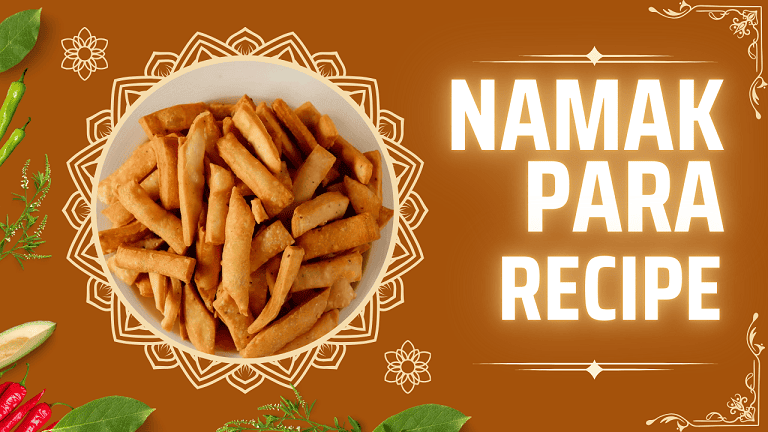Namak Para Recipe
Namak Para, also known as Namak Para or Salted Crisps, is a traditional Indian snack that is loved for its crispy texture and savory flavor. Often made during festive occasions or family gatherings, this delightful snack is a staple in many households across India.
Typically prepared from a simple mixture of flour and spices, Namak Para is fried until golden brown, making it an irresistible treat for those who enjoy munching on crunchy snacks.
This recipe focuses on using fresh, locally sourced ingredients that are readily available in India. Namak Para not only serves as a delicious snack but also offers a few health benefits, especially when made with whole grain flours and healthy oils.
The key ingredients—flour, spices, and oil—can be customized based on dietary preferences, making Namak Para a versatile option for various tastes. Moreover, it is a fantastic way to engage with traditional cooking practices and appreciate the cultural significance behind this beloved snack.
Ingredients
For a batch of approximately 40 pieces of Namak Para, you will need the following ingredients:
Dry Ingredients
- Whole wheat flour: 2 cups (rich in fiber and nutrients)
- Semolina (suji): ½ cup (adds crunch and texture)
- Salt: 1 teaspoon, or to taste
- Carom seeds (ajwain): 1 teaspoon (promotes digestion)
- Cumin seeds: 1 teaspoon (adds flavor)
- Red chili powder: ½ teaspoon (optional, for a hint of spice)
- Black sesame seeds: 1 tablespoon (for extra crunch and nutrition)
Wet Ingredients
- Ghee (clarified butter) or oil: 3 tablespoons (for richness)
- Water: ½ cup, or as needed to form the dough
Oil for frying
- Peanut oil or mustard oil: 2 cups (for deep frying)
Instructions
Prepare the Dough
Mix the dry ingredients: In a large mixing bowl, combine the whole wheat flour, semolina, salt, carom seeds, cumin seeds, red chili powder, and black sesame seeds. Stir well to ensure that all the ingredients are evenly mixed.
Add the ghee or oil: Warm the ghee slightly if it’s solid. Add it to the flour mixture and use your fingertips to rub it in until the mixture resembles coarse crumbs. This step is essential for achieving a crispy texture in the Namak Para.
Form the dough: Gradually add water to the mixture, a little at a time, while kneading. The dough should be firm but pliable. Avoid adding too much water to prevent the dough from becoming sticky. Once the dough is formed, cover it with a damp cloth and let it rest for 20-30 minutes.
Roll and Cut the Dough
Divide the dough: After resting, divide the dough into two portions. This makes it easier to handle and roll out.
Roll out the dough: On a lightly floured surface, roll out each portion into a thin sheet, about 1/8 inch thick. Aim for an even thickness to ensure uniform cooking.
Cut into shapes: Use a sharp knife or a pizza cutter to cut the rolled-out dough into small squares or diamond shapes, about 1-2 inches in size. Ensure the pieces are of uniform thickness for even frying.
Fry the Namak Para
Heat the oil: In a heavy-bottomed kadhai or deep pan, heat the oil over medium heat. To check if the oil is ready, drop a small piece of dough into the oil; it should rise to the surface slowly without browning too quickly.
Fry in batches: Carefully add the shaped dough pieces into the hot oil, making sure not to overcrowd the pan. Fry on medium-low heat, turning occasionally to ensure even cooking. The Namak Para should turn golden brown and crispy, which usually takes about 2-3 minutes per batch.
Drain excess oil: Once they are golden brown, remove the Namak Para from the oil using a slotted spoon and place them on a paper towel-lined plate to drain any excess oil.
Cool and Store
Allow to cool completely: Let the Namak Para cool down completely before storing them in an airtight container. This helps retain their crispness.
Store in an airtight container: Once cooled, store the Namak Para in a cool, dry place. They can last for up to 2-3 weeks, maintaining their crunchiness.
Maximizing Flavor and Nutrition
Choose whole grains: Using whole wheat flour instead of refined flour increases the fiber content, making the snack more nutritious and filling.
Add spices: Incorporating spices like carom seeds and cumin not only enhances flavor but also aids digestion, making the snack easier to digest.
Healthy frying oils: Opt for oils like peanut or mustard oil, which are not only great for frying but also offer health benefits. Mustard oil, for example, is known for its heart-healthy properties.
Variations and Substitutions
Namak Para can easily be customized to accommodate different dietary preferences and ingredient availability:
Vegan Namak Para
Replace ghee with vegetable oil or coconut oil to make the recipe vegan. Both alternatives work well and will not compromise the texture or flavor.
Gluten-Free Namak Para
For a gluten-free version, substitute whole wheat flour with a gluten-free flour blend or a combination of rice flour and gram flour (besan). Adjust the water content slightly, as gluten-free flours can require different amounts of liquid.
Spiced Namak Para
Experiment with different spices to create unique flavor profiles. You can add a teaspoon of garam masala for a more aromatic twist or sprinkle some dried herbs like oregano or rosemary into the dough for an herby version.
Baked Namak Para
For a healthier option, you can bake the Namak Para instead of frying. Preheat your oven to 180°C (350°F). Place the cut pieces on a greased baking tray, brush them lightly with oil, and bake for about 15-20 minutes or until golden brown and crispy, flipping them halfway through.
Tips for Preparing and Cooking
Kneading technique: When kneading the dough, ensure it is firm yet pliable. A well-kneaded dough leads to crispy Namak Para. Avoid using too much water, as this can result in a soft texture.
Resting the dough: Letting the dough rest allows the gluten to relax, making it easier to roll out and ensuring a crispier final product.
Frying temperature: Maintain a consistent frying temperature. If the oil is too hot, the Namak Para may burn on the outside while remaining uncooked on the inside. Conversely, if the oil is too cool, the Namak Para will absorb more oil and become greasy.
Serving Suggestions
Namak Para is versatile and can be served in various ways:
As a snack: Serve it as a standalone snack with a cup of tea or coffee. It pairs beautifully with the warmth and flavors of these beverages.
With dips: Offer a variety of dips alongside Namak Para, such as tangy tamarind chutney, spicy mint chutney, or yogurt-based dips to enhance the tasting experience.
As part of a festive platter: Arrange the Namak Para on a decorative platter with other traditional snacks and sweets during festivals or family gatherings. This adds visual appeal and variety to your spread.
Tips for Presentation
Rustic serving: Present Namak Para in traditional clay or wooden bowls to give a rustic feel. This enhances the overall experience and complements the homemade quality of the snack.
Garnish with herbs: For an elegant touch, garnish the serving bowl with fresh herbs such as cilantro or mint. This not only adds color but also a hint of freshness.
Use colorful serving dishes: Serve Namak Para in brightly colored dishes or platters to create an inviting visual contrast against the golden-brown hue of the crisps.
Conclusion
Namak Para is a delightful snack that brings together tradition, flavor, and nutrition. By focusing on using locally sourced, fresh ingredients, this recipe not only captures the essence of Indian culinary practices but also provides a healthier alternative to store-bought snacks.
With its crispy texture and savory flavor, Namak Para is perfect for any occasion, whether as an afternoon snack or a festive treat.
By making simple adjustments to the ingredients and preparation methods, you can easily cater to different dietary needs and preferences. Embrace the versatility of this classic snack and enjoy the process of creating a delicious, homemade treat that can be shared with family and friends. With its unique taste and satisfying crunch, Namak Para is sure to become a favorite in your household.
Thanks for visiting Veg Recipe

